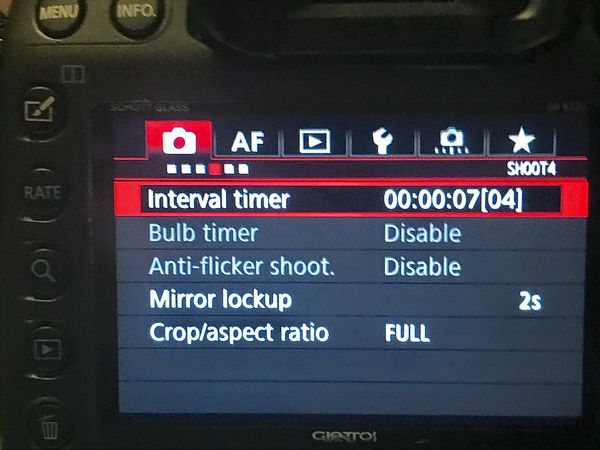Nikon D7000 can I use Mirror up with an Intervalometer?
Mar 3, 2021 23:06:38 #
I didn’t post this in Astrophotography because I wanted the most Nikon D7xxx users to see it. I’m using my D7000 for Astrophotography. Both with lenses & direct connected to my telescope. In order to have the sharpest images I want mirror up. I know how to use mirror up for individual exposures. Click once mirror up, 2nd click starts the exposure, all at least 15 seconds long. Using an Intervalometer how to I get the mirror up, stays up, and then take 10-50 or more individual exposures? Yes, I read the manual, but didn’t see the answer.
Thanks in advance, Dave
Thanks in advance, Dave
Mar 3, 2021 23:18:41 #
Exposures that long are not much bothered by the mirror. The vibes affect only the first moments, a very small % of a looooong exposure.
Mar 3, 2021 23:40:53 #
Mar 4, 2021 00:27:33 #
rcarol wrote:
Can't you use Live View?
If that works, prolly need an auxiliary power pack same as for video.
Mar 4, 2021 01:07:22 #
RWR
Loc: La Mesa, CA
Spiney wrote:
I didn’t post this in Astrophotography because I w... (show quote)
Your question is not subject-related, so you’re fine posting it here in Main Photography Discussion.
I’m not familiar with your camera, but I searched the online manual and the best I could determine is that the mirror returns after each exposure. My Df suffers the same design defect. Can’t even do double exposures. If I’m wrong, I hope someone corrects me.
I do what you want with an MF-23 databack on my F4, and could do the same with my F5 if I had an MF-28 back.
Mar 4, 2021 05:34:20 #
The exposure ends and the mirror returns to the down position, this is how my D7000 works. You just have to start the process over for the amount of shots wanted. A stacking software is then required to stack all images together.
Mar 4, 2021 07:41:20 #
Image below is of a Canon. Don’t happen to use a D7000. If you can find a menu screen similar to what is posted below, then you can set up the configuration you asked about.
Below you see a setup for a 4 frames sequence, at 7sec intervals, with a 2sec delay per frame after each mirror up. Hopefully you can find a similar menu in your own camera.
Don’t actually need this, but I tested it and it works as indicated in the menu.
.
Below you see a setup for a 4 frames sequence, at 7sec intervals, with a 2sec delay per frame after each mirror up. Hopefully you can find a similar menu in your own camera.
Don’t actually need this, but I tested it and it works as indicated in the menu.
.
Mar 4, 2021 09:17:08 #
User ID wrote:
Exposures that long are not much bothered by the mirror. The vibes affect only the first moments, a very small % of a looooong exposure.




Mar 4, 2021 18:41:39 #
It really doesn't mention an intervalometer option , but it does refer to the ML-L3 Remote. Since you have to press the button to raise the mirror and then press a second time to make the exposure, I don't know how the intervalometer can handle that two step process. Your best and surest option is a shutter release, and a steady hand.
Mar 5, 2021 01:30:22 #
Thank you all for your replies. Seems like the best option is to forgo the mirror up. Because in order to capture enough images for deep sky astrophotography I must use an Intervalometer. Either external, my favorite choice or the built in software. Often without an expensive guided tracking mount, the best option is many shorter images stacked together. This can give you the equivalent of a longer exposure.
I have a tracking mount, but it is not guided. So my longest exposures to date are 2 minutes at a time.
I’m starting to shoot with the camera attached to my old 70’s version Celestron C8 SCT. It tracks, but not very accurate over time. So with it, I’m currently exposing 20 seconds at a time. I may go longer but it’s the equivalent of FL-2000.
Thanks again. Spiney-Dave
I have a tracking mount, but it is not guided. So my longest exposures to date are 2 minutes at a time.
I’m starting to shoot with the camera attached to my old 70’s version Celestron C8 SCT. It tracks, but not very accurate over time. So with it, I’m currently exposing 20 seconds at a time. I may go longer but it’s the equivalent of FL-2000.
Thanks again. Spiney-Dave
Mar 5, 2021 02:45:25 #
RWR
Loc: La Mesa, CA
Spiney wrote:
Thank you all for your replies. Seems like the bes... (show quote)
Unless your tripod is not very steady, you likely will see no effects of mirror vibration with those long exposures.
If you want to reply, then register here. Registration is free and your account is created instantly, so you can post right away.



